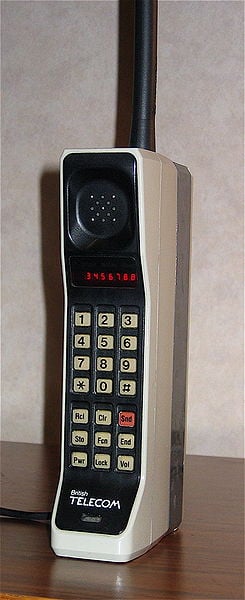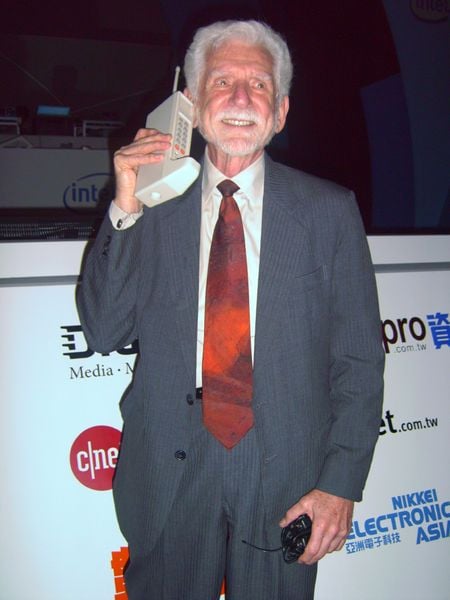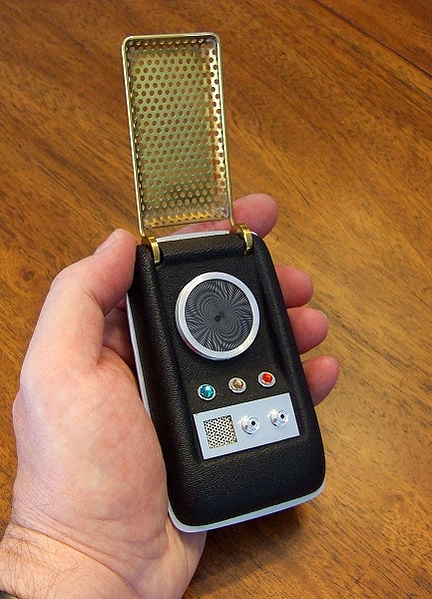- HubPages»
- Entertainment and Media»
- Movies & Movie Reviews»
- Science Fiction & Fantasy Films»
- Science Fiction
Is the Star Trek Communicator a SmartPhone
Who is Martin Cooper
Dr. Martin Cooper was born the day after Christmas in 1928 in Chicago, Illinois.
In the 1970s Dr. Cooper, working as project head at Motorola, began developing the first mobile phone. The objective was to create a hand-held phone that weight just two kilograms (4.4lbs). After ten years the team released the DynaTAC 8000x, the first publicly available completely mobile phone.
In order for the phone to work as a completely mobile device it had to have a strong battery, along with a two way radio that transmitted and received signals to and from a network of antennas placed in a regular pattern.
Since the pattern of antennas (base stations) were arranged in a grid the term coined for this network was a cellular since the grid resembled the cells in a honeycomb.

Mobile Phone
In 1973 here in the U.S. Dr. Cooper of Motorola finally brought all of the required components together to make a completely mobile telephone call. The first person he called was his rival Dr. Joel S. Engel of Bell Labs
In 1979 Nippon Telephone and Telegraph (NTT) Japan introduced a system in Tokyo. By the end of three years this system covered the entire Japanese island.
By 1981 Europe and the U.S. diverged in their mobile phone pursuits. Nordic Mobile Technology (NMT) was introduced in Denmark, Finland, Norway and Sweden.
By 1983 all of the infrastructure required for completely mobile calls was brought together in Chicago by Ameritech in using the Motorola DynaTAC (Dynamic Adaptive Total Area Coverage) mobile phone. Calling service into Mexico and Canada quickly followed. The DynaTAC was affectionately called "the brick" by some of its users.
All three of the phone systems above are considered First Generation (1G).


Birth of the Cell Phone
Long before cell phones there were car phones. As a practical matter these phones had to be installed either in a car, ship or within a building because they were so massive and the associated equipment so heavy.
Radio Phone
At that time the concept was actually called a radio phone. They began life as a means of communicating between ship and shore. Though this was World War II technology, the idea and it's practicality were widely accepted. After the war concerted efforts were made to shrink both the technology and the electrical power demands required of the equipment.
Car Phone
Shortly after the war the first car phone call was made in St. Louis, Missouri, USA on June 17, 1946. The phone used Bell System's Mobile Telephone Service, but the equipment weighed over eighty pounds (80 lbs). The service itself was basically a massive party line costing thirty dollars a month ($30). That is roughly three hundred fifty ($350) in 2010 dollars.
In the 1960s Sweden launched an automatic switching system for car phones that made the calls far less public. Because the phones used vacuum tubes and relays they were still pretty heavy at forty kilograms (40kg) or eighty-eighty (88lbs) pounds. Calls were dialed on a rotoray dial. This system was called Mobile System A (MTA). MTA operated at one hundred sixty (160KHz) KiloHertz.
Two years (1962) later Mobile System B (MTB) was launched including phones that used transistors and pushbutton dialing. These phones had pushbutton dialing and operated in the seventy-six to seventy-seven point five (76–77.5MHz) MegaHertz to eighty-one to eighty-two point five MegaHertz (81–82.5 MHz) range. It is estimated there were about six hundred subscribers; mostly business.
In 1971 MTD was introduced. It operated at the four hundred fifty MegaHertz band (450 MHz) and lasted until 1987. It was eventually made obsolete by the NMT automatic service. At the peak there were twenty thousand subscribers (20,000) with seven hundred (700) operators.
Digital Cell Phone Calling
It wasn't until 1991 that cellular phone signals went from analog to digital. The system was called Global System for Mobile Communications (GSM) by Radiolinja in Finland. GSM was the preferred cellular technology in both Europe and the United States until High-Speed Downlink Packet Access (HSDPA) was introduced.
In 2001 Japan raced ahead with Wideband Code Division Multiple Access (WCDMA). This system was introduced by NTT DoCoMo. The DoCoMo is an abbreviation of "do communications over the mobile network."
Inspiration and Future Improvement
Dr. Cooper claims that while working for Motorola on the truly mobile phone project he happened to notice an episode of Star Trek. The moment he saw the communicator he knew what a mobile phone should be. (see video below)
Problems with Wireless
Dr. Cooper cites the following five points as ongoing problems for cellular communications in the year 2010.
- Though most cellular transmission antenna are outdoors, most cell phone conversations take place indoors. This causes communications problems and signal attenuation/loss that still needs to be addressed.
- Though the internet has proved beyond doubt that an open environment is fertile ground for innovation and invention, the cellular industry clings to what he calls the "walled garden" concept of closed networks. Open cellular networks could very well bring the innovation and inspiration that the Internet brought.
- Because cellular towers and stations are designed send and receive signals in a spherical pattern, a great deal of radio power is lost to the atmosphere. There should be a way to steer these signals to tighter areas where 95% of the cell users happen to be. This would save on energy costs and provide the customer with better service.
- Seventy percent (70%) of the cell phone's use is for voice communications, less than thirty percent (-30%) for text and an even smaller percent for email communications. Yet carriers and manufacturers continue to produce phones for all three functions along with high pressure marketing "do everything phones" and for high bandwidth speeds. Most people don't really need this much power for day to day use and it makes cellular communications more expensive than it might be.
- Consumers are often presented with the illusion that they are getting a phone for almost nothing, when in fact the contract makes the $200 phone in reality a $600~$800 item. Worse, once the contract is up or new models come out, consumers are encouraged to throw the old devices away. They are also difficult to recycle.
Solutions to Wireless Problems
- Dr. Cooper would like to see the implementation of what he calls femtocells. A femtocell is an antenna designed to serve small specific areas. You could have, for instance, a femtocell in your house that is connected to the larger cellular network.
- Open networks. Dr. Cooper would like to see public, open cellular networks that are not owned exclusively by any one company. Along with that he'd like to see open operating systems for cellular devices. He feels that with these two changes in place true innovation can begin. He likes the concept of Android by the way.
- Smart antenna. Dr. Cooper would like to see antenna that are only on-line and broadcasting and receiving when there's actually something to broadcast or receive. As of now cell towers are always active whether there are signals to process or not. He feels that microcomputers and software could drastically reduce the cost of cellular communications and make the entire network more efficient.
- More specifics; less everything and the kitchen sink. Dr. Cooper believes that the carriers and manufacturers need to get back to basics because not everyone wants a phone that does everything. He feels that the current spate of devices are not what most people want and offerings of cell-phone only (a cell phone that only makes phone calls) should have a wide market.
Second Cellular Revolution
With the adoption of some of the above ideas Dr. Cooper believes we could see a second cellular revolution. With adaptive antenna and low costs single purpose phones we could see a true boost in broadband speeds and see a world where everyone can afford a cellular phone.
Disclaimer
The author was not compensated in any way, either monetarily, with discounts, or freebies by any of the companies mentioned.
Though the author does make a small profit for the word count of this article none of that comes directly from the manufacturers mentioned. The author also stands to make a small profit from advertising attached to this article.
The author has no control over either the advertising or the contents of those ads.










